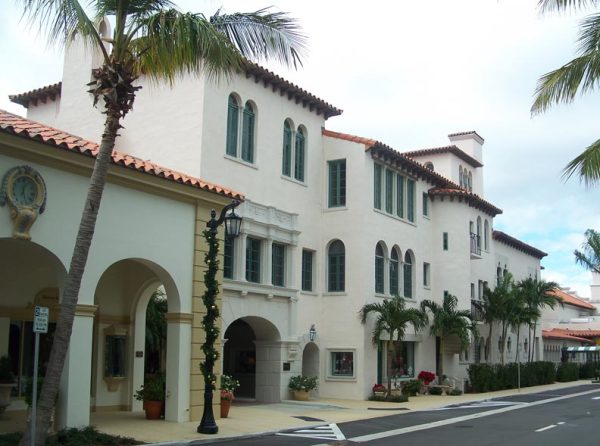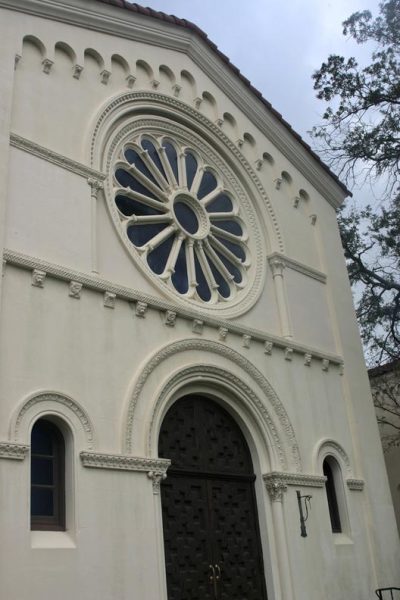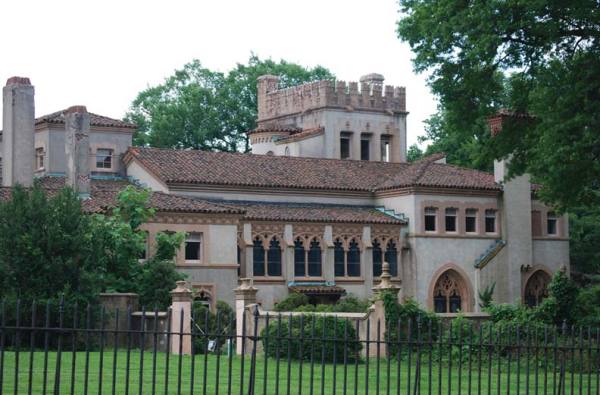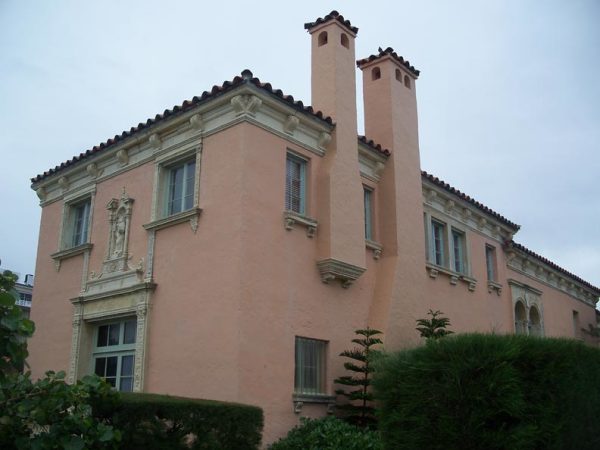
The Everglades Club was Mizner’s first commission in Palm Beach. (Photo: Ebyabe/Wikipedia)
Born in 1872, Addison Mizner spent the majority of his developmental years in Spain and Central America due to his father’s job as the U.S. minister to Guatemala. By the age of 16, he had absorbed nearly every aspect of Spanish culture and heritage. Though he never acquired a formal university education in architecture, he studied design everywhere he went. After serving apprenticeships to architects for more than 10 years, Mizner uprooted to Palm Beach in the winter of 1918 for health reasons. Via his myriad wealthy acquaintances, Mizner scored an opportunity to design the Everglades Club for his companion, sewing machine heir Paris Singer. It was this design that drove Mizner straight to the top of architectural success. At the peak of his career, he designed more than 50 villas and mansions for wealthy American families. Here are 8 of his most famous commissions.
Everglades Club
The Everglades Club (pictured above) was the young architect’s first major commission in Palm Beach. Still used as a private golf club, it is a secluded retreat for an elite 1,000 members, the names of which have included Pillsbury, Pulitzer, Sanford, and Vanderbilt. Mizner’s own factories turned out baronial wrought-iron chandeliers, handmade tiles, and sweeping murals for the building, elements that are today lovingly preserved by the curators of the Everglades Club.
El Solano
Dually named—for Mizner’s birthplace of Solano County, California, and the stifling winds of the Spanish-Mediterranean coast— this asymmetrical home in Palm Beach was constructed in 1925 as Mizner’s own residence. It features numerous floor-to-ceiling casement windows. as well as his classic pavilion flanks. Mizner sold the mansion to Harold Vanderbilt, who turned it into a social hotspot for the rich and famous. Years later, John Lennon and Yoko Ono bought the Spanish Revival residence, but the couple spent just two weeks in the home before Lennon’s tragic death.
Riverside Baptist Church

The northern and southern trancepts of the Riverside Baptist Church in Jacksonville are dominated by large rose windows. (Photo: Riverside Baptist Church)
Mizner eventually branched out beyond the beach when in 1924, the Riverside Baptist group offered him full creative license to design a church. The architect was renowned by this time and was glad to accept the offer; however, he refused any monetary compensation, claiming that the project would commemorate the life of his late mother. Having never delved into a religious design, Mizner conjured a blueprint bursting with flavors of Byzantine, Spanish, and Romanesque designs. With his traditional craftsmanship, Mizner even created a way to age the building’s exterior stucco walls by rubbing them with buttermilk and burnt umber. Inside, majestic Moorish arches lead eyes to the chancel, while intricate wrought iron grills enclose the choir area. The church remains intact today and was added to the National Register of Historic Places in 1973.
La Guerida
Better known as The Kennedy Estate, this 11-bedroom Spanish Revival mansion was originally designed in 1923 for department-store tycoon Rodman Wannamaker. The Palm Beach home changed hands in 1933 to Joe Kennedy for a measly $120,000. The Kennedy family ruled the roost over the next several decades, as the estate became host to countless political events, vacations, and even a winter White House for JFK where he composed his inaugural speech. In 1995, the estate was sold to the Castle family for nearly $5 million; they performed extensive restorations to the worn-out home according to Mizner’s original plans.

La Ronda, in its former glory. (Photo: Carla J. Zambelli, from the book La Ronda in Photos)
La Ronda
One of the rare projects Mizner commissioned above the Mason-Dixon Line, the 17,500-square-foot, 51-room La Ronda was a whimsical sight in Bryn Mawr, Pennsylvania, for 80 years. Leather-manufacturer Percival E. Foerderer and his family owned the home from 1929 until 1969, when it was sold to Villanova University. Over the next four decades, the ownership changed hands numerous times, and the surrounding land diminished from 233 to a mere 3.2 acres to make room for housing developments. Despite a concerted effort by local preservation activists, the house was demolished by new owners in October 2009.
El Mirasol
After winning the design-heart of Eva Stotesbury (the queen bee of Palm Beach in the ‘20s) at a chance meeting at the Everglades Club, Mizner indirectly usurped the commission for the Stotesbury’s third mansion from Horace Trumbauer. El Mirasol’s 40-acre stretch of land boasted blossoming gardens, a luscious orange grove, a large yacht dock, and even a private zoo. The 40-room Spanish Revival home had all the classic features—loggias and patios, towers and turrets, romantic balconies. Unfortunately, the Stotesburys’ fortunes slowly dried up, and by Eva’s death in 1946, the sprawling land around El Mirasol had dwindled to 12 acres. El Mirasol was the first of Mizner’s work to face the wrecking ball in the 1950s—the only thing spared was the entrance gate, which was deemed a historic landmark by the state of Florida in 1980. Today, the land is a 14-lot development known as El Mirasol Estates.
William Gray Warden House

Its pink exterior and double chimneys make the Warden House hard to miss. (Photo: Ebyabe/Wikipedia)
This salmon-colored Mediterranean Revival home in Palm Beach was added to the National Register of Historic Places in 1984. Its unique double chimneys pull focus above the perfectly straight hedges that surround the residence like a moat. This 1922 project saw Mizner blending Colonial Revival details with his typical Mediterranean and Spanish styles, including 128 hand-carved Romanesque columns. When Warden originally met with Mizner in 1921, the Pittsburgh Coal Company chairman wanted a quaint 32-room home “that wouldn’t overshadow the nearby houses.” Instead, Mizner convinced Warden to adopt a new design at three times the original budget. In 1983, Robert Eigelberger saved the the city-block-wide mansion from the clutches of a developer and turned it into six condominium apartments, retaining its original features.
Boca Raton Administration Buildings
Riding high on his architectural success in Palm Beach, in 1925 Mizner headed a syndicate that bought land in Boca Raton with the dream of creating “the world’s most architecturally beautiful playground.” He intended for the city’s administration buildings to serve as a visual aid to his clients of his vision for Boca Raton. Based on the architecture of Mizner’s personal favorite building—El Greco in Toledo, Spain—the structure encompassed sales offices, drafting rooms, a restaurant, and even a small office for Mizner. Today, the buildings remain as historic landmarks in Florida and are still home to various offices as well as The Addison restaurant.







